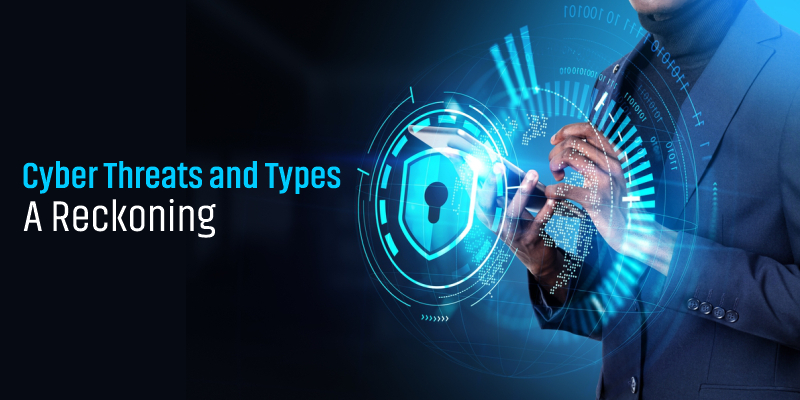Cyber Threats and Types: A Reckoning

A Brief Cyber-threats
Cyber threats refer to malicious attacks and security breaches aimed at damaging, disrupting, or stealing sensitive information stored in computer systems or networks. With the increasing reliance on technology, these threats are becoming more common and impacting every sector. In 2020, cyberattacks were ranked as the fifth greatest risk in the public and private sectors.
Cyber threats can be from a wide range of entities, e.g. security breaches, attacks from hacktivists, terrorist groups, judicial nation-states, criminal syndicates, and solitary hackers. Moreover, as per research, the number of IoT cyberattacks alone is anticipated to double by 2025, and this risky industry will most likely continue to expand in 2023.
The estimated annual cost of cybercrime to organisations will surge from $3 trillion to $10.5 trillion by 2025.Cybersecurity Ventures further notes that cybercrime constitutes the largest transfer of economic value in history, with a growth rate of 15% year over year.
Therefore, for small organisations or corporate giants, it is important to stay vigilant and implement appropriate security measures to protect their systems and sensitive information against these threats. This includes implementing strong security policies, using antivirus and anti-malware software, and regularly updating and patching systems.
What is Cyber Security?
Cyber security refers to the practice of protecting computer systems, networks, and digital devices from unauthorised access, theft, or damage to their hardware, software, or electronic data. According to the World Economic Forum’s “Global Cybersecurity Outlook 2022,“ cyberattacks have increased as the pace of digitalization has accelerated since the outbreak of Covid -19. This includes measures to prevent and mitigate cyber-attacks, as well as ensure the confidentiality, integrity, and availability of sensitive information.
Types of Cyber Security
- Network Security: This type of cyber security protects computer networks and systems from unauthorised access, theft, or damage.
- Application Security: This type protects applications and software from potential threats, such as malware or hacking attacks.
- Endpoint Security: This type of security is focused on protecting endpoints, such as laptops, smartphones, and other devices, from cyber-attacks and unauthorised access.
- Cloud Security: This type of security is designed to protect cloud-based applications and systems from cyber threats, including data breaches and hacking attacks.
- Database Security: This type of security is focused on protecting sensitive data stored in databases from unauthorised access and cyber-attacks.
- Identity and Access Management (IAM): This type of security involves managing user identities and access to systems and applications, ensuring that only authorized users can access sensitive information.
- Internet of Things (IoT) Security: IoT security-connected devices are frequently used to hold sensitive data but are typically not designed to be protected. IoT security tools make IoT devices more visible and increase their security.
What is a Threat to Cyber Security?
A Threat to Cyber Security refers to any malicious action or activity that seeks to exploit or harm the security of a computer network or the devices connected to it. These threats can take various forms, including hacking, malware, phishing, and social engineering, and can result in theft or loss of confidential data, disruption of services, financial loss, and damage to reputation. Cybersecurity threats are constantly evolving and becoming more sophisticated, and organisations must be proactive in protecting themselves from these risks.
7 Types of Threats
Cyber-Threats can have a wide range of effects on a company, from minor operational disruptions to significant financial crises.
Now that you have some understanding of cyber threats and security, let’s learn about the most 7 common types of Cyber Threats:
-
- Malware: Malware is a major security threat to computer users and organizations, it can steal sensitive information, corrupt files, or even destroy data. This can be done with viruses, Trojans, worms, spyware, adware, and ransomware, among others. And it can be any single one or a combination of any two or more. For example, in 2017, the WannaCry ransomware attack affected over 300,000 computers in 150 countries, causing widespread panic and financial losses.
- Phishing: A type of social engineering attack that aims to trick users into revealing sensitive information, such as passwords or financial information like credit card numbers. Phishing attacks can also be carried out through phone calls, text messages, or instant messaging.
- SQL Injection: A web application security vulnerability that allows the attacker to inject malicious code into an SQL database through a web form or user input. This can result in unauthorized access to sensitive information or the manipulation of data in the database.
- Man-in-the-Middle Attack (MITM): An attack in which a hacker intercepts communication between two parties and can modify or steal information. The attacker acts as a middleman, disguising themself as one of the parties involved in the communication and relaying messages between the two parties, manipulating the data being transmitted.
- Denial of Service (DoS) Attack: Denial of Service (DoS) works by disrupting the normal functioning of a website or network by overwhelming it with an excessive amount of traffic. The goal of this attack is to prevent legitimate users from accessing the website or network, causing inconvenience, frustration, and financial losses of significant magnitude. An example of a DoS attack occurred in 2016 when a botnet of internet-connected devices known as the Mirai Botnet was used to launch a massive DoS attack against a DNS provider, Dyn.
- Emotet: Emotet, attackers use it as a Trojan Horse to steal sensitive information from bank customers.This malicious software is being used in the longest-running cybercrime operations and originally appeared in 2014 as a banking trojan. In 2019, this malware variant Emotet rose to its prominence. It got recognized as the most dangerous and persistent threat facing the banking industry today.
- Password Attacks: The name itself defines the characteristics of this attack, Intruders use various methods and techniques to gain unauthorized access to an account by cracking or guessing the password. In June 2011, NATO (North Atlantic Treaty Organization) suffered a security breach that led to the public release of first and last names, usernames, and passwords of more than 11,000 registered users of their e-bookshop. The data were leaked as part of Operation AntiSec, a movement that includes Anonymous, LulzSec, and other hacking groups and individuals.
- Social Engineering Attacks: Social engineering entails persuading people to act as a malware entry point. Because the attacker assumes the identity of a trustworthy actor, the victim shares sensitive information or unintentionally downloads malware onto their device. For example, Baiting, Phishing, Piggybacking, and Tailgating.
- Supply Chain Attacks: For software sellers and developers, supply chain threats are a new threat. Its goal is to spread malware through software update systems, build processes, and source code to infect legal apps. These attacks are alarming because the apps being hacked are authorized and authenticated by trusted providers.
Final Thoughts
As the pace of business adaptation has accelerated, every sector of the economy has been driven to adopt new technologies. Whenever a security innovation is made, there are also threats that gain access to the system.
To secure their data and operations, businesses and government organizations need the highest level of cyber security. Therefore, cyber security specialists must comprehend how to handle the most rapidly emerging cyber threats.
To give working professionals an edge in the job market in this constantly changing technology environment, RACE has crafted tech-driven professional cybersecurity programs.
M.Tech /M.Sc. in Cybersecurity Program From RACE, REVA University
In the wake of increasing threats and a growing need for technology to prevent them, cybersecurity is a hotbed for job seekers, making choosing the right program in the field a crucial decision.
RACE, REVA University offers M.Tech/M.Sc. in Cybersecurity program, in association with Microsoft AZURE & AWS developed as per the guidance from renowned industry thought leaders from a variety of industries, including IT, ITES, e-commerce, and more. The program ensures exposure to the advanced infrastructure setting to create a virtual simulator-like working atmosphere for cyberattack scenarios.
If you’re interested in advancing your knowledge & skills enrolling for RACE, REVA University Cybersecurity Master’s program will be one of the best choices. For further information, you may visit https://bit.ly/3jHw3b1



